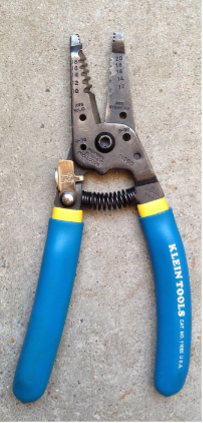Competency F3: Install Plumbing Fixtures and Appliances
Learning Task 1
Describe the commissioning of fixtures and appliances
By commissioning a fixture or appliance, you verify that it is fully functional, meets quality standards, and is ready for operation. This process helps identify and address any issues or deficiencies before the equipment is put into service which will minimize the risk of failures, malfunctions, or safety hazards.
Tools and Equipment
Whether commissioning a tap, a home, or an entire commercial building, certain tools and equipment will be needed. Here are some of the basics:
- Screwdrivers
- Adjustable wrenches
- Pliers
- Pipe wrench
- Electrical tester/multimeter
- Level
- Tape measure
- Pipe cutter
- Putty knife
- Wire strippers
- Compressor
- Safety equipment
Multiple screwdrivers may be needed to open panels, secure brackets, or connect wiring. Adjustable wrenches are useful for tightening or loosening nuts, bolts, or hose connections. Pliers will be needed for gripping and manipulating small parts or wires. Electrical testers are used for checking voltage, continuity, and electrical connections to ensure safe installation. A pipe cutter is handy for plumbing connections involving threaded pipes or fittings. A knife will be useful for scraping off old sealants, adhesives, or caulk before installing or replacing components. Wire strippers (Figure 1) will be necessary if you need to work with electrical wires and strip the insulation for proper connections.

A compressor will be needed where pressure testing is required. It’s always important to consider safety, so have gloves, safety glasses, and potentially a dust mask or respirator, depending on the appliance and the work involved.
System Check/Test
A big part of the commissioning process is doing a comprehensive system check and test. Ideally, when you are doing a test on an appliance, you allow the appliance to run through its entire cycle.
For example, a thorough system check for a dishwasher may follow this sequence:
- Read the dishwasher manual
- Load the dishwasher
- Check the dishwasher settings
- Add dishwasher detergent
- Close the dishwasher door securely
- Start the test cycle
- Observe the dishwasher operation
- Listen for water filling the dishwasher
- Check if the dishwasher drains properly
- Look for any leaks
- Test the heating and drying function (if applicable)
- Check for error codes (if applicable)
- Evaluate the cleanliness of the dishes
If you notice any issues during the test, refer to the dishwasher manual for troubleshooting advice. If any leaks occur, check the connection between the water supply line and the dishwasher and the dishwasher’s drain and its connection to the sanitary system. Make sure the connections are tight and proper sealants are used. Many threaded connections will use Teflon, but if the connection has a rubber washer, Teflon is not required.
An example of commissioning a boiler may go something like this:
- Visually inspect the boiler and its surroundings, leaks, or corrosion. Check the vents and flues to ensure they are clear and not blocked.
- For boilers with a sight glass, check the water level to ensure it is within the recommended range. If the boiler uses a low-water cutoff device, verify that it is functioning correctly. You will need to isolate the make up water and the supply and return lines. Call for heat, and slowly drain the boiler. The low water cut off should stop the burner when the water drops below the allowable level.
- Use a pressure gauge to check the boiler’s pressure. The pressure should be within the recommended operating range, as specified in the manufacturer’s guidelines. Those can be found on the manufacture’s website if you don’t have the documentation.
- If the boiler is a gas or oil-fired boiler, inspect the combustion chamber for any signs of soot, carbon buildup, or debris.
- Conduct a flue gas analysis to measure the boiler’s combustion efficiency and ensure it is not producing dangerous levels of carbon monoxide (CO). The expected levels is found in the manufacture’s specifications.
- Test the boiler’s safety devices, including the pressure relief valve, temperature and pressure relief (TPR) valve, and any other safety controls. Flow switches can be tested by isolating the supply or return to stop the flow.
- Observe the boiler during startup and operation to ensure it follows the correct firing sequence. This includes proper ignition, flame detection, and burner operation.
- If the boiler is atmospherically vented, verify that the boiler room has adequate ventilation to allow for the safe discharge of combustion gases.
- Monitor the water temperature in the boiler to ensure it matches the desired set point and meets the requirements for the application.
- Check the entire heating system, including pipes, radiators, and valves, for any leaks. Leaks can lead to reduced efficiency and potential damage to the boiler and surrounding components.
Manufacturers’ Specifications
Manufacturers’ specifications are a guide for the installation of products (Figure 2) that meet predefined quality standards, safety regulations, and customer expectations. They provide a set of standards and requirements that a product must meet to guarantee quality and performance. They outline the desired characteristics, features, and functionalities of the product, serving as a benchmark for manufacturers to follow during the installation process.

Specifications often include safety guidelines and regulatory requirements that products must meet. Compliance with these specifications helps protect consumers from potential hazards or risks associated with the product. In many industries, products need to work together seamlessly or be compatible with other components or systems. Specifications provide guidelines on the dimensions, interfaces, and technical requirements necessary for interchangeability. Specs also define the expected performance and functionality of a product. They outline parameters such as speed, capacity, power consumption, accuracy, durability, and other relevant characteristics.
Specs can play a crucial role in warranty agreements. They define the acceptable limits, operating conditions, and usage guidelines for the product. Manufacturers may refer to these specifications to determine if a product qualifies for warranty coverage and to assess any potential misuse or abuse that may void the warranty, therefor it is important to follow their instructions when installing a fixture or appliance and in the subsequent inspection. Specifications also provide a basis for troubleshooting and support, allowing service personnel to identify and address issues effectively.
Inspection
Inspectors work for local government agencies, building departments, or other regulatory bodies. They play a crucial role in maintaining the integrity and safety of plumbing systems in communities and contribute to the overall quality of construction projects. When plumbing work is completed, it is important to have that work inspected. Arrange an inspection with the local agency with advanced notice and don’t forget that part of an inspectors’ job is to help you along the way. If there are questions or concerns about how to install an appliance or fixture to code, an inspector can help. Custom fixtures or appliances
Adjustments
During the commissioning process, it is likely that some deficiencies will be discovered. Document those findings and make arrangements to have them fixed. Easy fixes can be done immediately, however, equipment malfunctions will need to logged and reported back to the manufactures so that they can provide further instruction. Remember that warranties need to be considered when making adjustments. Do not perform any fixes that would compromise the integrity of the warranty. After adjustments have been made, the fixture or appliance will be recommissioned before return it to service.
Documentation
Documenting the testing process provides a clear record of the activities performed, verifies compliance with regulations, and serves as a reference for future maintenance or troubleshooting. It is important to follow any specific documentation requirements or guidelines provided by local authorities, regulatory bodies, or industry standards when commissioning fixtures and appliances.
Inform End-User of Operation
When you have completed the commissioning and testing of an appliance you should inform the customer. Show them the appliance or fixture and demonstrate that it is ready for use. Provide any necessary instructions for future care. If you are billing the customer, provide a detailed invoice that includes a breakdown of the charges, including parts and labour. Clearly explain the invoice if necessary. Accept payment and issue a receipt or pass along the relevant billing information to your company. Clean up any mess created during the service and always leave the customer’s premises in the same condition as you found it, or better.
 Now complete Self-Test 1 and check your answers.
Now complete Self-Test 1 and check your answers.
Self-Test 1
Self-Test 1
Media Attributions
- Figure 1. “Wire strippers” from Electrical Installation and Maintenance Guide for students is used for educational purposes under the basis of fair dealing.
- Figure 2. “Navien Installation Manual” from Navien is used for educational purposes under the basis of fair dealing.

